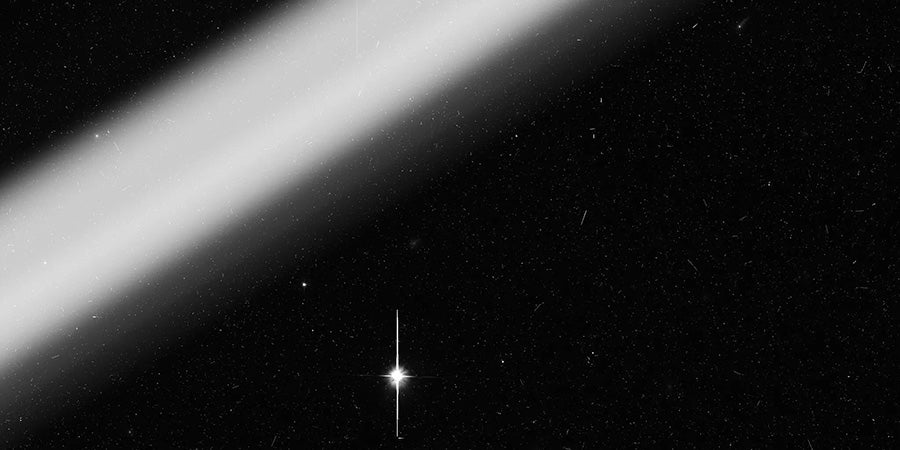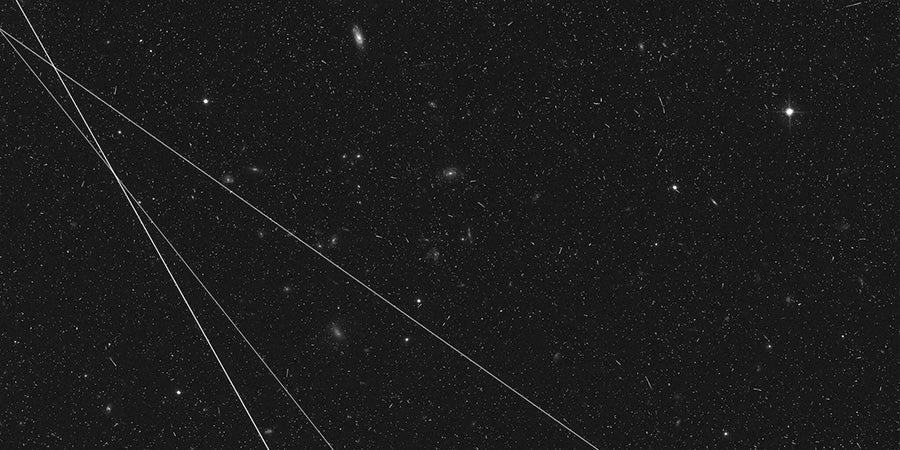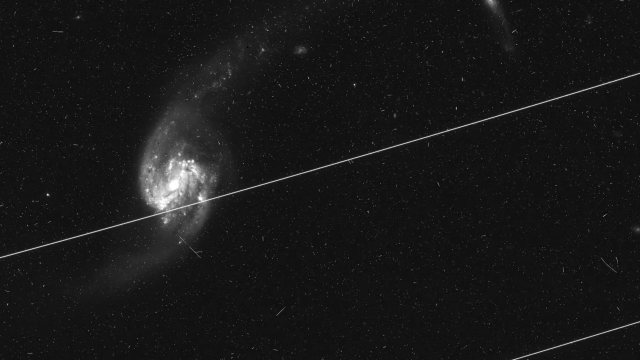The steadily growing satellite population has been posing challenges for ground-based astronomy, but new research reveals that space-based telescopes like Hubble are also suffering.
Satellites in low Earth orbit (LEO) spin around Earth once every 90 minutes. Factor in the thousands upon thousands of satellites currently working in orbit, and you can quickly grok the problem as far as ground-based astronomy is concerned. Constellations such as Starlink and OneWeb greatly exacerbate the issue, producing annoying streaks in astronomical imagery. So serious is the situation that scientists have declared satellite constellations an “existential threat for astronomy.”
Space-based astronomy might seem like an obvious solution, with SpaceX founder Elon Musk suggesting as much in a May 2019 tweet. Research published this week in Nature Astronomy suggests otherwise, showing the extent to which the Hubble Space Telescope is being impacted by these burgeoning satellite swarms.

The research, led by Sandor Kruk from the Max Planck Institute for Extraterrestrial Physics in Germany, found that 3.7% of Hubble images taken from 2009 to 2020 were tarnished by satellite streaks. By 2021, this number had risen to 5.9%. There were 1,562 Starlink and 320 OneWeb satellites in orbit at the time, “increasing the population of satellites close to the orbit” of Hubble, the scientists write.
For the study, the researchers looked at more than 100,000 individual Hubble images contributed by over 10,000 citizen scientists working on the Hubble Asteroid Hunter project. A deep learning algorithm was trained to spot images marred by satellite streaks and ignore similar trail-like features caused by natural phenomena, such as asteroids, gravitational lensing, and cosmic rays.
Data for this analysis stopped in 2021, but it’s now two years later, and with so many more satellites currently working in orbit, the problem is undoubtedly much worse. Moreover, and as Kruk and colleagues grimly conclude: “With the growing number of artificial satellites currently planned, the fraction of Hubble Space Telescope images crossed by satellites will increase in the next decade and will need further close study and monitoring.”

The 33-year-old Hubble may be long in the tooth, but it’s still performing critical scientific work, whether it be hunting for asteroids, monitoring NASA experiments, or simply gazing into the heavens. That satellite swarms are having a detrimental effect on space-based astronomy is obviously not good.
“We’re going to be living with this problem. And astronomy will be impacted,” Jonathan McDowell, an astronomer at the Harvard-Smithsonian Centre for Astrophysics, told the New York Times in reference to the new study. “There will be science that can’t be done. There will be science that’s significantly more expensive to do. There will be things that we miss.”
Astronomers, in an attempt to prevent the situation from getting worse, have been organising and agitating accordingly. In the most recent development, an international collaboration petitioned the United Nations for help, asking it to assemble an expert group on the matter.
In the meantime, astronomers aren’t completely helpless, as they can apply various data and filtering techniques to identify and potentially salvage spoiled images. And as NASA told the New York Times, “the majority of affected images are still usable.” This said, the added time and cost to astronomical research is hardly ideal.
Astronomers are also asking satellite operators to do their part, such as making their satellites less reflective. In response to such requests, SpaceX has been experimenting with some mitigation techniques for Starlink, such as using dark paint to absorb sunlight. Unfortunately, this particular “mitigation was less effective than desired,” according to SpaceX. Other approaches, namely a visor to block reflective sunlight and orientation adjustments to minimise surface area, have proven to be “highly effective,” the company claims. SpaceX is also experimenting with “dielectric mirror film,” which directs light away from Earth.
Hubble is currently operating some 540 kilometres above the surface, which is roughly 10 km lower than some of the highest Starlink satellites. A solution might be to significantly raise Hubble’s orbit, which has shrunk dramatically over the decades. NASA and SpaceX are currently hatching a plan to determine if such a thing is possible.
As an aside, the recently deployed Webb Space Telescope is immune to satellite streaks, as it’s working 1.5 million km away in the second Lagrange point.
Raising Hubble’s orbit could work, but that would serve as small consolation to the other telescopes currently operating in low Earth orbit and those currently under development, such as China’s upcoming Xuntian space telescope. This remains a problem in search of a solution.
